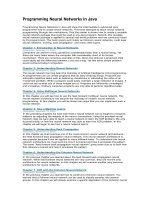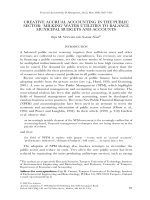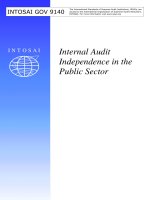VoIP in the Public Networks
Bạn đang xem bản rút gọn của tài liệu. Xem và tải ngay bản đầy đủ của tài liệu tại đây (832.48 KB, 24 trang )
7
VoIP IN THE PUBLIC NETWORKS1
VoIP technology is currently mature enough to be implemented in public
networks (PSTN, cable TV [CATV], etc.), at least for long-distance telecom-
munications services to both residential and corporate customers. Either a pri-
vate IP-based network (an Intranet) or an IP-based VPN can be used to guar-
antee the required QoS (call acceptance/drop rate, voice quality, etc.). In order
to launch VoIP in the access loop, IP-based local access over digital subscriber
line (DSL) or Ethernet in the first mile (EFM, IEEE P802.3ah) access, CATV
networks, and wireless local loop (WLL) can be utilized. For corporate cus-
tomers, the PSTN network can provide a variety of DSL-based access links to
o¤er centrex features and functions and intersite IP-PBX connectivity, as dis-
cussed in Chapter 6.
In this chapter, we discuss evolution of various public network infrastruc-
tures (e.g., PSTN, CATV, etc.) to o¤er VoIP-based basic and advanced tele-
phony services, either by using new IP-based network elements that are capable
of supporting PSTN interfaces or by upgrading or modernizing the existing
Telco-grade (i.e., the network equipment building system [NEBS]–compliant)
PSTN elements with IP-based line cards, servers, and so on.
IP-BASED TANDEM OR CLASS-4 OR LONG-DISTANCE SERVICES
In traditional PSTN terminology, if the calling and called parties are not served
by the same CLASS-5 central o‰ce (CO) switch or cloud, then one or more
93
1 The ideas and viewpoints presented here belong solely to Bhumip Khasnabish, Massachusetts,
USA.
CLASS-4 or tandem-level switches and a transport network (see, e.g., Fig. 1-1
of Chapter 1) are required for establishing the connection between the two
parties. That transport switch–based intermediate network constitutes a multi-
connected and highly protected network that is commonly known as a long-
distance (LD) or inter-LATA network, and the call becomes an LD call. In
PSTN (circuit-switched) networks, to deliver high-quality voice, it is very com-
mon to use two-connected synchronous optical network (SONET) [1] ring-
based transport networks with 50 msec of restoration time. PSTN networks use
TDM-based circuit switching with a multiplexing hierarchy of DS0 (64 Kbps)
to DS1 (or T1 or 1.544 Mbps), DS1 to DS3 (or T3 or 44.736 Mbps), and then
OC-1 (51.84 Mbps) to OC-3 (STS-3 or STM-1), OC-3 to OC-12 (STS-12 or
STM-4), and so on. Note that the DS0 to DS1/T1 multiplexer uses the byte
interleaving technique, whereas the DS1 to DS3/T3 multiplexer uses the bit
interleaving technique for multiplexing the information from the channels [1].
The requirement of 50 msec restoration time for transport was derived from
the fact that any loss of information or fault with a duration of less than
50 msec in the transport network would not trigger any action—such as call
drop or rerouting of trunks—at the lowest (T1 to T3 at the digital cross-
connect system, etc.) multiplexing level. This also helps maintain the one-way
end-to-end (ETE) delay of 150 msec, which is required to guarantee toll-quality
(i.e., a MOS value of 4.0) voice signal transmission. This type of overprotection
and overdesign guarantees both stability and higher-quality LD voice tra‰c
transmission, but the cost of service is also very high (e.g., 25 to 30 cents per
minute for a telephone call from Boston, Massachusetts, to San Francisco,
California).
With the advent of VoIP, various next-generation LD service providers are
deploying an IP-based transport network or leasing IP-based transport capacity
along with the required network elements. These network elements interact
with the transmission, call control, and feature servers of the PSTN network
to deliver LD voice service—of varying quality—at a fraction of the cost of a
telephone call from Boston to San Francisco. In addition, using appropriate
shared redundancy, it is possible to achieve sub-50-msec restoration of trans-
port services.
The customer can use 10-10-xxx based dialing, or they can dial a local phone
number or a toll-free number (e.g., 1-800 or 1-888) to reach the desired IP-
based call server. After proper authentication and authorization, the caller can
proceed to dial the desired phone number for an LD call.
Table 7-1 presents a list of traditional CLASS-4 or LD services, features,
and capabilities that the next-generation LD service providers need to support
using an IP-based network, GWs, and service elements or servers. A detailed
list of all of the CLASS-4 features and services can be found in the corre-
sponding generic requirements (GRs) developed by Telcordia (www.saic.com/
about/companies/telcordia.html, formerly Bellcore) for PSTN networks.
94
VoIP IN THE PUBLIC NETWORKS
Elements Required to O¤er VoIP-Based LD Service
Figure 7-1 shows one possible implementation of VoIP-based LD service that
can be used as a model for gradual deployment of most CLASS-4 services. The
required network elements are as follows:
a. IP-PSTN media gateways (MGWs) that interact with the PSTN network
via access (e.g., T1-PRI/CAS) and trunking (e.g., intermachine trunk
[IMT] with the speed of T1 or T3) links of CLASS-5-type central o‰ce
switches;
b. An SS7 [3] SG that interprets the call setup and control messages from
the SS7 network to the VoIP network, and vice versa;
c. A VoIP call server that controls the calls and IP-PSTN MGWs, and
interacts with the billing system to capture the call detail records (CDRs)
and put them in the appropriate format to generate customers’ bills for
the service;
d. Firewalls and other security enforcement devices (servers) to ensure that
the calls originate from and terminate to the authorized endpoints, and
TABLE 7-1 Traditional CLASS-4 and LD Service and Features
Advanced intelligent network triggers (AIN 0.1 and 0.2 triggers)
Basic toll-free services like 1-800 and 1-888 dialing, national and international calling
services, and so on
Caller ID and automatic identification of calling party’s number (ANI)
Call/customer detail billing reports
Calling card service (prepaid and postpaid, with real-time update of balance)
Cellular Feature Group C and D trunk access (þ/À)
Dialed number identification service (DNIS)
Emergency alternate routing within a prespecified time interval
Enhanced toll-free routing (e.g., NPA-NXX, time of day, day of week)
Feature Group B, C, and D SS7 trunk access
Feature Group B, C, and D multifrequency (MF) trunk access
Handling of ISDN user part (ISUP) and transaction capabilities applications part
(TCAP) messages
Interface with SS7 network using A-F links
Interface with the interactive voice response (IVR) system
ISDN primary rate interface (PRI) trunk access
Local number portability (LNP) service
Routing of overflow calls, dial-around service using a four- to six-digit LD carrier
selection code
Support of calling card fraud detection
VPN and software-defined network for voice VPN service
Wiretap service (communications assistance for law enforcement act [CALEA])
Zero þ/À,1þ, etc. dialing for LD operator assistance and LD network access
IP-BASED TANDEM OR CLASS-4 OR LONG-DISTANCE SERVICES
95
that privacy and security of communications are guaranteed to the extent
possible using the existing technologies, but as good as that of the PSTN
networks (this may be di‰cult to achieve cost-e¤ectively); and
e. An IP-based Intranet or VPN over the public Internet that can guar-
antee certain amount of bandwidth (e.g., 100 Kbps for G.711 coded voice
signal without silence suppression) per admitted voice call with a pre-
specified amount of delay variation (e.g., less than 20 msec) and loss of
packets (e.g., less that 3%).
A Simple Call Flow
Let us look at a very simple call setup scenario at a very high level where the
LD call is routed over an IP network instead of a PSTN transport network.
The CLASS-5 switch is providing a dial tone and other call access and delivery
services to the phones at both the calling and called parties’ premises.
The call control intelligence, which resides at the VoIP call server, receives
the PSTN call setup messages via the SS7 SG or IP-PSTN MGW. When IMT-
type links are used to connect the IP-PSTN MGW to the Intranet, call setup
messages flow through the SS7 signaling gateway. When T1-PRI/CAS links are
Figure 7-1 Deployment of VoIP for CLASS-4 services (TDM: circuit-switched
link, e.g., T1-CAS/PRI, T1/T3-IMT; IP: IP-based link; DS0: basic or 64 Kbps digital
channel).
96
VoIP IN THE PUBLIC NETWORKS
used to connect the IP-PSTN MGW to the Intranet, call setup messages flow
through the same IP-PSTN MGW.
This ingress VoIP call server is also aware—via the system configuration—
of the IP address of the ingress (call-originating) IP-PSTN MGW. It uses
information from PSTN domain call setup messages—such as the initial
address message (IAM, from the call-originating side)–type PSTN call setup
message—to determine the E.164 addresses (telephone numbers) of the calling
and called parties and to initiate a VoIP session between them using VoIP call
control and signaling, as discussed in Chapters 2 and 3.
The ingress VoIP call server then uses H.225 (LRQ/LCF), SIP-T, or BICC
messages—as discussed in Chapter 3—to determine the location of the egress
VoIP call server. The egress VoIP call server returns the IP address of the IP-
PSTN MGW, which can directly terminate the requested PSTN call. For the
sake of simplicity, the ingress and egress VoIP call servers are shown in the
same box in Figure 7-1.
At the same time, the egress CLASS-5 PSTN switch starts processing the
incoming call setup request by capturing a two-way circuit and then checking
for the availability of the called party by sending an ‘‘alerting’’ (for digital
phone set) or ‘‘ring’’ (for analog phone set) message. The received response
is the address complete message (ACM, a type of ISUP message [3]) that is
received from the call-terminating side and is propagated to the call-originating
side over (a) the SS7 network if the ingress, egress, and transport networks use
PSTN or circuit-switching technologies or (b) the SS7 and IP networks if VoIP-
based CLASS-4 or LD voice service is implemented. If the called telephone is
not busy, the calling party hears the ring-back tone; otherwise, the called party
is busy, and the calling party hears a busy tone. These tones are encapsulated
over VoIP call control and signaling messages for transmission over the IP
transport network (Intranet or VPN, as shown in Fig. 7-1).
If the called party is idle and answers the phone call (i.e., the handset goes
o¤-hook), a ‘‘connection request’’ message is initiated from the egress side. This
message is equivalent to the answer message (ANM, a type of call setup mes-
sage) in the SS7 [3] network that initiates the billing process for the call. An
RTP tunnel or session (see Chapter 2 and Reference 4 for details) is now
established between the ingress and egress IP-PSTN MGWs by using the pre-
specified RTP port numbers, as administered by the ingress and egress VoIP
call servers. This RTP session runs over UDP/IP across the Intranet or VPN
shown in Figure 7-1. The requested LD voice communication can now con-
tinue over this RTP session via appropriate mapping of the RTP session to the
ingress and egress circuits, with the local access and delivery still using TDM or
circuit-switch-based CLASS-5 networks.
As soon as the call is completed, either the caller or the called party goes on-
hook, and the disconnect event sends the call release (REL, an ISUP message
for call control [3]) message toward the other direction from the endpoint that
initiated the on-hook action. A release complete (RLC, an ISUP message for
call control [3]) now travels in the opposite direction—that is, toward the end-
IP-BASED TANDEM OR CLASS-4 OR LONG-DISTANCE SERVICES
97
point that initiated the on-hook action—to release the circuits on the access
and delivery sides (both PSTN) of the network. The REL and RLC messages
are translated into appropriate VoIP call control and signaling messages (e.g.,
BYE in SIP, Delete-Connection in MGCP, etc., as discussed in Chapter 3) to
terminate the RTP session between the ingress and egress IP-PSTN MGWs in
the IP-based transport network.
Network Evolution Issues
The main advantage of VoIP-based LD service is that customers enjoy flat
monthly rate–based billing for the calls within national boundaries. This is due
to the fact that the voice sessions are transported over a distance-insensitive
and shared IP-based network instead of over a circuit-switched PSTN transport
network. Other advantages of VoIP-based LD service include (a) flexibility
to customize the service per customers’ requirements and (b) the ability to rap-
idly roll out new and emerging value-added services using server-based tech-
nologies. These advantages are enabling the Internet service providers (ISPs)
and the competitive local exchange carriers (CLECs) to o¤er all-distance, IP-
based voice or telephony services at discounted prices.
However, there are a few major issues that need to be addressed before
VoIP-based LD service can achieve PSTN-grade quality, reliability, availabil-
ity, and security. These include guaranteeing 99.999% of reliability and avail-
ability of services, consistently o¤ering high-quality (e.g., toll grade or a MOS
score of 4.0) voice transmission, and ensuring circuit-switch-type security of
services.
As technologies improve, the IP network and related technologies will be
able to support better availability, security, and quality of access, transmission,
and delivery of voice tra‰c. These evolving technologies include one or more
of the following:
a. Routing the packets for real-time voice sessions using an overprovisioned
or overcapacity-based voice-grade transport network (e.g., one-way ETE
delay of less than 100 msec, delay variation of less than 20 msec, and
packet loss of less than 3%; for G.711, a coded voice signal without
silence suppression with 20 msec of voice sample or packet);
b. Administration of voice call admission on the basis of ETE monitoring of
multiplexing, storage, and bandwidth or transmission resources;
c. Categorization of real-time voice and loss-sensitive data into separate
streams so that they can be multiplexed over di¤erent sets of RTP and
UDP ports and, if required, can even be routed over di¤erent sets of IP
addresses to guarantee the required quality of service; and
d. Deployment of IP version 6 (IPv6, IETF’s RFC 2460/1883) or IP version
4 (IPv4, IETF’s RFC 791) with IPSec infrastructure in the network.
98
VoIP IN THE PUBLIC NETWORKS
Many next-generation network element manufacturers and service providers
are exploring the e¤ectiveness of these technologies for VoIP service in the pilot
networks. These are discussed further later in this chapter and in Chapter 9.
It is well known [1–4] that PSTN networks are inherently more secure and
reliable than VoIP networks and are capable of providing high-quality of
transmission. However, they are neither open nor flexible enough to accom-
modate new value-added services as rapidly as VoIP-based networks.
Using the architecture shown in Figure 7-1, VoIP-based LD and other
CLASS-4 services can be deployed as per the service capacity and capability
requirements. For example, one can start with one VoIP call server, two IP-
PSTN MGWs, a firewall and network address translator (NAT) device, and a
VPN with a few call-originating and -terminating sites at the beginning. Then,
as the demand increases, a network of VoIP call servers can be created, with
each server controlling a cluster of IP-PSTN MGWs, and so on.
For large-scale deployment, service providers may consider using the archi-
tecture framework shown in Figure 1-9, as recommended by the Multiservice
Switching Forum (MSF) in their recently published implementation agree-
ments (available at www.msforum.org/techinfo/approved.shtml, 2001). The
beauty of this architecture is that the functional elements used here are su‰-
ciently modular or granular, and the interactions among these elements can
occur over, IP links using various open or standard VoIP protocols such as
SIP, MGCP, Megaco/H.248, and SCTP. These make the network architecture
more scalable, growable, and proof of any emerging technologies. In addition,
these characteristics can help the service providers launch new and emerging
services—such as Internet call waiting, customized criteria-based call forward-
ing, instant messaging and conferencing, and so on—very quickly and eco-
nomically.
VoIP IN THE ACCESS OR LOCAL LOOP
In residential access networks, IP-based real-time voice or telephony service
can be o¤ered using a variety of access networking technologies. Recent devel-
opments in the technologies for access networking and physical transmission
have significantly contributed to delivering broadband services to the home
(BTTH, [5]). These include digital subscriber line (DSL, www.dslforum.org,
www.dsllife.com, 2001) technologies, Ethernet in the first mile (EFM, www.
efmalliance.org, 2001) technology, packet-cable and data over cable service
interface specifications (DOCSIS, www.packetcable.com, 2001) technologies,
and various WLL technologies. These are discussed in details in References 4
to 6.
In PSTNs, traditionally CLASS-5 switches along with twisted-pair copper
wire–based local loops, are used to o¤er telephony service using channel asso-
ciated signaling (CAS) [1,4,6]. Table 7-2 presents a list of the most widely used
CLASS-5 features and services. A detailed list of all of the CLASS-5 features
VoIP IN THE ACCESS OR LOCAL LOOP
99
TABLE 7-2 Widely Used CLASS-5 Features and Services
Automatic callback: automatic redialing of the last number dialed
Automatic recall: automatic dialing of the last incoming caller’s phone number
Call blocking: blocking of certain outgoing calls by the subscriber
Call pickup: answering a call to one line from another line location by using an access
code
Call transfer: transferring calls from one line to another
Call waiting: flashing of a text message (in the display of the phone set) or a back-
ground audio message/tone to announce a second incoming call
Call forwarding—busy line: forwarding incoming calls to another number when the
dialed telephone is busy
Call forwarding—don’t answer: forwarding incoming calls to another number when
the call is not answered
Call forwarding—universal: unconditional forwarding of incoming calls to another
number
Call forwarding—call-waiting calls: forwarding incoming call-waiting calls to another
number
Call forward—remote activation: activation of call forwarding remotely from any
other phone
Call hold: putting an active call on hold in order to pick it up from another line
Call intercept or anonymous caller rejection: intercepting or rejecting all incoming calls
that block delivery of the caller’s telephone number, name, or both
Caller’s name and number (caller ID) delivery: displaying the calling party’s telephone
number and name after one ring
Called ID blocking: to blocking the calling party’s identification (name, number, or
both)
Cancel call waiting: special prefix code (e.g., *70) based dialing to cancel the call wait-
ing feature for the duration of a call
Call tracing: activation of the incoming call tracing
Centrex features: the PSTN-hosted voice call processing feature used by business cus-
tomers (discussed in Chapter 6)
Distinctive ringing: delivering di¤erent ring tones based on the number dialed over a
single line
Extension bridging: programming one telephone number for multiple locations
(requires the call forwarding and speed dial functions)
Make line/set busy: access code–based activation of ‘‘phone/line busy’’ appearance
Message waiting indication (MWI): a visual signal–based indication of the waiting
messages (with display of time and date stamps)
Regulatory features: supporting the emergency dialing (911), directory assistance (411),
CALEA, and other features and services
Selective call acceptance, forwarding, and rejection: preprogrammed lists–based accep-
tance, forwarding, and rejection of the incoming calls
Speed dialing: programming soft or hard buttons (using a one- or two-digit code) in the
phone set for frequently dialed phone numbers
Teen services: caller ID and/or called number–based distinctive ringing, distinctive call
waiting, directing the caller to a special mailbox, and so on
Three-way calling: conferencing with three callers
100
VoIP IN THE PUBLIC NETWORKS
and services can be found in the corresponding generic requirements (GRs) that
have been developed by Telcordia (www.saic.com/about/companies/telcordia.
html, formerly Bellcore) for PSTN networks. Although more than 3000
CLASS-5 features have been developed, those presented in Table 7-2 are most
useful and popular. Many of these services are CLASS-5 switch feature based,
and some of them are SS7 network [3] based. For example, call waiting, call
forwarding, three-way calling, and speed dialing are switch-based services,
whereas automatic recall/call back, distinctive ringing, call trace, and selective
call rejection are SS7 network-based services. In the next-generation PSTNs,
the switch-based features and services may reside in the carrier-grade general-
purpose computer servers with an IP interface, enabling the service providers
to roll out new services quickly and economically. However, the VoIP-based
telephony service may need higher bandwidth than that needed for circuit-
switch-based telephony. For example, G.711-based voice coding needs 64 Kbps
circuits for real-time voice communication over a circuit-switched (PSTN)
network, whereas with the same G.711 coding, because of PPP/MAC/Ethernet,
RTP, UDP and IP overheads, VoIP transmission needs more than 100 Kbps of
bandwidth, as shown in Figure 2-2 of Chapter 2. In addition, very often, VoIP
uses the same channel or pipe that is carrying non-real-time bursty packets for
other services. Consequently, the challenges are to make VoIP-based telephony
services as reliable, robust, bandwidth-e‰cient, and secure as those in the
circuit-switch-based PSTN networks, without making network implementation
and operation more expensive than that of PSTN.
The CATV or community antenna television (CATV, www.catv.org, 2001)
network is another type of residential network that can be used to o¤er IP-
based, real-time voice or telephony service. The newly allocated return path
band (5 to 40 MHz) and the forward path band (600 to 750 MHz) [5,6] can be
used to o¤er VoIP/IP telephony, as well as other advanced two-way video and
entertainment (broadband) services. This can be achieved without jeopardizing
the traditional TV and Internet data services that are delivered over other
TABLE 7-2 (Continued)
Utility telemetry service: utility companies’ access to subscriber lines to receive utility
usage data for billing purposes
Universal CLASS feature access: usage-based billing for access to the universally
deployed CLASS features
Voice mail service: PSTN network host-based voice message recording by a caller and
subsequent processing (retrieval, deleting, forwarding, archiving, etc.) by the called
party
Wake-up call service: programming an incoming call at a prespecified time for wake-up
service
Wide area telephone services (WATS): the capability that allows customers to make
(OUTWATS) or receive (INWATS) LD calls and to have them billed on a bulk
rather than an individual call basis
VoIP IN THE ACCESS OR LOCAL LOOP
101









